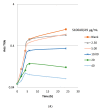Immune Modulating Topical S100A8/A9 Inhibits Growth of Pseudomonas aeruginosa and Mitigates Biofilm Infection in Chronic Wounds
- PMID: 28672877
- PMCID: PMC5535852
- DOI: 10.3390/ijms18071359
Immune Modulating Topical S100A8/A9 Inhibits Growth of Pseudomonas aeruginosa and Mitigates Biofilm Infection in Chronic Wounds
Abstract
Pseudomonas aeruginosa biofilm maintains and perturbs local host defense, hindering timely wound healing. Previously, we showed that P. aeruginosa suppressed S100A8/A9 of the murine innate host defense. We assessed the potential antimicrobial effect of S100A8/A9 on biofilm-infected wounds in a murine model and P. aeruginosa growth in vitro. Seventy-six mice, inflicted with a full-thickness burn wound were challenged subcutaneously (s.c.) by 10⁶ colony-forming units (CFUs) of P. aeruginosa biofilm. Mice were subsequently randomized into two treatment groups, one group receiving recombinant murine S100A8/A9 and a group of vehicle controls (phosphate-buffered saline, PBS) all treated with s.c. injections daily for up to five days. Wounds were analyzed for quantitative bacteriology and contents of key inflammatory markers. Count of blood polymorphonuclear leukocytes was included. S100A8/A9-treatment ameliorated wound infection, as evaluated by quantitative bacteriology (p ≤ 0.05). In vitro, growth of P. aeruginosa was inhibited dose-dependently by S100A8/A9 in concentrations from 5 to 40 μg/mL, as determined by optical density-measurement (OD-measurement) and quantitative bacteriology. Treatment slightly augmented key inflammatory cytokine Tumor Necrosis Factor-α (TNF-α), but dampened interferon-γ (IFN-γ) levels and blood polymorphonuclear count. In conclusion, topical S100A8/A9 displays remarkable novel immune stimulatory and anti-infective properties in vivo and in vitro. Importantly, treatment by S100A8/A9 provides local infection control. Implications for a role as adjunctive treatment in healing of chronic biofilm-infected wounds are discussed.
Keywords: Pseudomonas aeruginosa; S100A8/A9; biofilm infection; chronic wounds; host defense.
Conflict of interest statement
The authors declare no conflict of interest.
Figures






Similar articles
-
Chronic Pseudomonas aeruginosa biofilm infection impairs murine S100A8/A9 and neutrophil effector cytokines-implications for delayed wound closure?Pathog Dis. 2017 Sep 29;75(7). doi: 10.1093/femspd/ftx068. Pathog Dis. 2017. PMID: 28645160
-
Synergistic effect of immunomodulatory S100A8/A9 and ciprofloxacin against Pseudomonas aeruginosa biofilm in a murine chronic wound model.Pathog Dis. 2020 Jul 1;78(5):ftz027. doi: 10.1093/femspd/ftz027. Pathog Dis. 2020. PMID: 31116394
-
Adjunctive S100A8/A9 Immunomodulation Hinders Ciprofloxacin Resistance in Pseudomonas aeruginosa in a Murine Biofilm Wound Model.Front Cell Infect Microbiol. 2021 Apr 12;11:652012. doi: 10.3389/fcimb.2021.652012. eCollection 2021. Front Cell Infect Microbiol. 2021. PMID: 33912476 Free PMC article.
-
Murine burn lesion model for studying acute and chronic wound infections.APMIS. 2022 Jul;130(7):477-490. doi: 10.1111/apm.13228. Epub 2022 May 16. APMIS. 2022. PMID: 35441434 Review.
-
Immune Responses to Pseudomonas aeruginosa Biofilm Infections.Front Immunol. 2021 Feb 22;12:625597. doi: 10.3389/fimmu.2021.625597. eCollection 2021. Front Immunol. 2021. PMID: 33692800 Free PMC article. Review.
Cited by
-
Anti-Biofilm Enzymes-Assisted Antibiotic Therapy against Burn Wound Infection by Pseudomonas aeruginosa.Antimicrob Agents Chemother. 2023 Jul 18;67(7):e0030723. doi: 10.1128/aac.00307-23. Epub 2023 Jun 5. Antimicrob Agents Chemother. 2023. PMID: 37272814 Free PMC article.
-
Insights into Host-Pathogen Interactions in Biofilm-Infected Wounds Reveal Possibilities for New Treatment Strategies.Antibiotics (Basel). 2020 Jul 10;9(7):396. doi: 10.3390/antibiotics9070396. Antibiotics (Basel). 2020. PMID: 32664205 Free PMC article. Review.
-
It takes two for chronic wounds to heal: dispersing bacterial biofilm and modulating inflammation with dual action plasma coatings.RSC Adv. 2020 Feb 18;10(13):7368-7376. doi: 10.1039/c9ra09875e. eCollection 2020 Feb 18. RSC Adv. 2020. PMID: 35492196 Free PMC article.
-
A novel method for treatment of pseudomonas pyogenic hepatic abscess complicating an echinococcal cyst by irrigation with acetic acid. A case report and literature review.IDCases. 2021 Jun 10;25:e01186. doi: 10.1016/j.idcr.2021.e01186. eCollection 2021. IDCases. 2021. PMID: 34189036 Free PMC article.
-
Priming With Toll-Like Receptor 3 Agonist Poly(I:C) Enhances Content of Innate Immune Defense Proteins but Not MicroRNAs in Human Mesenchymal Stem Cell-Derived Extracellular Vesicles.Front Cell Dev Biol. 2021 May 24;9:676356. doi: 10.3389/fcell.2021.676356. eCollection 2021. Front Cell Dev Biol. 2021. PMID: 34109180 Free PMC article.
References
-
- Malone M., Bjarnsholt T., McBain A.J., James G.A., Stoodley P., Leaper D., Tachi M., Schultz G., Swanson T., Wolcott R.D. The prevalence of biofilms in chronic wounds: A systematic review and meta-analysis of published data. J. Wound Care. 2017;26:20–25. doi: 10.12968/jowc.2017.26.1.20. - DOI - PubMed
-
- Trøstrup H., Bjarnsholt T., Kirketerp-Møller K., Høiby N., Moser C. What is new in the understanding of non healing wounds. Ulcers. 2013;2013:625934. doi: 10.1155/2013/625934. - DOI
MeSH terms
Substances
LinkOut - more resources
Full Text Sources
Other Literature Sources
Medical

